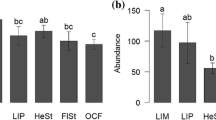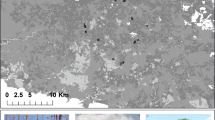Abstract
Substantial industrial development, agricultural intensification, and an increasing human population have led to the demise of many seminatural habitats, such as wet meadows, in many countries of Europe. This process can cause the extinction and decline of associated insect species. The present paper is the first study analyzing wild bee diversity and abundance patterns in wet meadows. We surveyed bees using pan traps, transect walks, and nest traps in four Molinietum (Poaceae) meadows near Kraków, Poland. During one season, we identified a relatively high γ-diversity of wild bees, consisting of 105 species (13 from the Polish Red List) belonging to 22 genera, which represent almost one-fourth of the Polish bees. The wild bee fauna between sites was not variable, which was indicated by low ß-diversity. We found that nesting preference of bees did not differ between the study area and xerothermic meadows, which suggests that differentiation in bee fauna of wet and dry grasslands is mostly due to food specialization rather than nesting preference. Abundance analysis of the bee community showed that the least abundant species were disproportionately comprised of oligolectic species, indicating that species closely associated to plants of wet meadows are especially threatened. Moreover, using occurrence data we found that 34% of the species belonging to the families Halictidae, Melittidae, and the tribe Nomadini found in wet meadows are considered rare in Poland. Our results highlight an urgent need to perform further investigations and develop specific protection plans for bees not only in Kraków’s Molinietum meadows, but also in wetlands throughout Europe.
Similar content being viewed by others
Literature Cited
Banaszak, J. 1995. Changes in Fauna of Wild Bees in Europe. Pedagogical University Press, Bydgoszcz, Poland.
Banaszak, J. 2002. Apoidea. p. 80–87. In Z. Glowacinski (ed.) Red List of Threatened Animals in Poland. ISEZ PAS Press, Kraków, Poland.
Banaszak, J., T. Cierzniak, R. Kriger, and J. Wędzonka. 2006. Bees of xerothermic swards in the lower Vistula valley: diversity and zoographic analyses (Hymenoptera: Apoidea: Apoformes). Polish Journal of Entomology 75: 105–54.
Biesmeijer, J. C., S. P. M. Roberts, M. Reemer, R. Ohlemüller, M. Edwards, T. Peeters, A. P. Schaffers, S. G. Potts, R. Kleukers, C. D. Thomas, J. Settele, and W. E. Kunin. 2006. Parallel declines in pollinators and insect-pollinated plants in Britain and the Netherlands. Science 313: 351–54.
Böhm, A. 2000. Uaktualnienie i Rozszerzenie Planu Koordynacyjnego dla III Kampusu UJ wraz z Parkiem Technologicznym do Wystapienia o WZiZT. Instytut Architektury Krajobrazu i Instytut Planowania Komputerowego Politechniki Krakowskiej, Kraków, Poland.
Calabuig, I. 2000. Solitary Bees and Bumblebees in Danish Agricultural Landscape. Ph.D. Dissertation. University of Copenhagen, CITY, Denmark.
Celary, W. 1995. Nomadini (Hymenoptera, Apoidea, Anthophoridae) of Poland. ISEZ PAS Press, Kraków, Poland.
Celary, W. 2005. Melittidae of Poland (Hymenoptera: Apoidea: Anthophila). Their Biodiversity and Biology. ISEZ PAS Press, Kraków, Poland.
Cox-Foster, D. L., S. Conlan, E. C. Holmes, G. Palacios, J. D. Evans, N. A. Moran, P. L. Quan, T. Briese, M. Hornig, D. M. Geiser, V. Martinson, D. vanEngelsdorp, A. L. Kalkstein, A. Drysdale, J. Hui, J. Zhai, L. Cui, S. K. Hutchinson, F. J. Simons, M. Egholm, J. S. Pettis, and W. I. Lipkin. 2007. A metagenomic survey of microbes in honey bee colony collapse disorder. Science 318: 283–87.
Droege, S. 2002. Impact of color and size of bowl trap on numbers of bees captured. http://online.sfsu.edu/beeplot/pdfs/ color%20and%20size.pdf. Accessed 3 June 2008.
Dubiel, E. 1996. Łąki Krakowa. Część I. Klasa Molinio-Arrhenatheretea. Studia Ośrodka Dokumentacji Fizjograficznej 24: 145–71.
Dubiel, E. 2003. Łąki Krakowa —ginący element krajobrazu. Aura 11: 27–29.
Dylewska, M. and B. Wiśniowski. 2003. Żądłówki (Hymenoptera, Aculeata) Ojcowskiego Parku Narodowego. Ojcowski Park Narodowy, Ojców, Poland.
Evertz, S. 1995. Inter-specific competition amongst honey-bees (apis mellifera) and solitary wild bees (Hymenoptera, apoidea). Natur und Landschaft 70: 165–72.
Garcia, A. 1992. Conserving the species-rich meadows of Europe. Agriculture, Ecosystems and Environment 40: 219–32.
Gibbs, J. P. 2000. Wetland loss and biodiversity conservation. Conservation Biology 14: 314–17.
Goulson, D. 2003. Bumblebees. Behaviour and Ecology. Oxford University Press, New York, NY, USA.
Hirsch, M. and V. Wolters. 2003. Response of aculeata Hymenoptera to spatial features of an agricultural landscape. Journal for Nature Conservation 11: 179–85.
Hitsamatsu, M. and S. Yamane. 2006. Faunal makeup of wild bees and their flower utilization in a semi-urbanized area in central Japan. Entomological Science 9: 137–45.
Kearns, C. A., D. W. Inouye, and N. M. Waser. 1998. Endangered mutualisms: the conservation of plant-pollinator interactions. Annual Review of Ecology and Systematics 29: 83–112.
Kenta, T., N. Inari, T. Nagamitsu, K. Goka, and T. Hiura. 2007. Commercialized European bumblebee can cause pollination disturbance: an experiment on seven native plant species in Japan. Biological Conservation 134: 298–309.
Klein, A., I. Steffan-Dewenter, and T. Tscharntke. 2003. Fruit set of highland coffee increases with the diversity of pollinating bees. Proceedings of the Royal Society of London, Series B 270: 955–61.
Kosior, A., W. Celary, P. Olejniczak, J. Fijał, W. Król, W. Solarz, and P. Plonka. 2007. The decline of the bumble bees and cuckoo bees (Hymenoptera: Apidae: Bombini) of Western and Central Europe. Oryx 41: 79–88.
Kremen, C., N. M. Williams, and R. W. Thorp. 2002. Crop pollination from native bees at risk from agricultural intensification. Proceedings of the National Academy of Sciences USA 99: 16812–16.
Michener, C. D. 2000. The Bees of the World. The Johns Hopkins University Press, Baltimore, MD, USA.
National Research Council. 2007. Status of Pollinators in North America. National Academies Press, Washington, DC, USA.
Oertli, S., A. Müller, and S. Dorn. 2005. Ecological and seasonal patterns in the diversity of a species-rich bee assemblage (Hymenoptera: Apoidea: Apiformes). European Journal of Entomology 102: 53–63.
O’Toole, C. 1993. Diversity of native bees and agroecosystems. p. 169–96. In J. LaSalle and I. Gauld (eds.) Hymenoptera and Biodiversity. Commonwealth Agricultural Bureau International, London, UK.
Pesenko, Y. A., J. Banaszak, V. G. Radchenko, and T. Cierzniak. 2000. Bees of the Family Halictidae (excluding Sphecodes) of Poland: Taxonomy, Ecology, Bionomics. Pedagogical University Press, Bydgoszcz, Poland.
Potts, S. G., A. Dafni, and G. Ne’eman. 2001. Pollination of core flowering shrub species in Mediterranean phrygana: variation in pollinator diversity, abundance and effectiveness in response to fire. Oikos 92: 71–80.
Roubik, D. W. 1995. Pollination of Cultivated Plants in the Tropics. Food and Agricultural Organisation Service Bulletin 118. Food and Agricultural Organisation, Rome, Italy.
Russell, K. N., H. Ikerd, and S. Droege. 2005. The potential conservation value of unmowed powerline strips for native bees. Biological Conservation 124: 133–48.
Sárospataki, M., J. Novák, and V. Molnár. 2005. Assessing the threatened status of bumble bee species (Hymenoptera: Apidae) in Hungary, Central Europe. Biodiversity and Conservation 14: 2437–46.
Saunders, D. A., R. J. Hobbs, and C. R. Margules. 1991. Biological consequences of ecosystem fragmentation: a review. Conservation Biology 5: 18–32.
Schluter, D. and R. E. Ricklefs. 1993. Species Diversity: Historical and Geographical Perspectives. University Chicago Press, Chicago, IL, USA.
Schnittler, M. and K. F. Günther. 1999. Central European vascular plants requiring priority conservation measures —an analysis from national Red Lists and distribution maps. Biodiversity and Conservation 8: 891–925.
Settele, J., V. Hammen, P. Hulme, U. Karlson, S. Klotz, M. Kotarac, W. Kunin, G. Marion, M. O’Connor, T. Petanidou, K. Peterson, S. Potts, H. Pritchard, P. Pysek, M. Rounsevell, J. Spangenberg, I. Steffan-Dewenter, M. Sykes, M. Vighi, M. Zobel, and I. Kühn. 2005. ALARM: Assessing LArge-scale environmental Risks for biodiversity with tested Methods: the concept, objectives, structure and management of a large Integrated Project within the 6th framework programme of the European Commission. Gaia 14: 69–72.
Skórka, P., J. Settele, and M. Woyciechowski. 2007. Effects of management cessation on grassland butterflies in southern Poland. Agriculture, Ecosystems and Environment 121: 319–24.
Spira, T. P. 2001. Plant-pollinator interactions: a threatened mutualism with implications for the ecology and management of rare plants. Natural Areas Journal 21: 78–88.
Sporek, M. and A. Rombel-Bryzek. 2005. Wetland restoration enhances the development of protected species (Iris siberica L.) —a case study. Polish Journal of Ecology 53: 591–95.
Steffan-Dewenter, I. 2003. The importance of habitat area and landscape context for species richness of bees and wasps in fragmented orchard meadows. Conservation Biology 17: 1036–44.
Steffan-Dewenter, I. and T. Tscharntke. 2002. Insect communities and biotic interaction on calcareous grasslands —a minireview. Biological Conservaion 104: 275–84.
Tommasi, D., A. Miro, H. A. Higo, and M. L. Winston. 2004. Bee diversity and abundance in an urban setting. Canadian Entomologist 136: 851–69.
Tscharntke, T., A. Gathmann, and I. Steffan-Dewenter. 1998. Bioindication using trap-nesting bees and wasps and their natural enemies: community structure and interactions. Journal of Applied Ecology 35: 708–19.
van Swaay, C. 2002. The importance of calcareous grasslands for butterflies in Europe. Biological Conservation 104: 315–18.
Westrich, P. 1990. Die Wildbienen Baden-Württembergs. Ulmer, Stuttgart, Germany.
Williams, I. H. 1994. The dependence of crop pollination within the European Union on pollination by honey bees. Agricultural Zoology Reviews 6: 229–57.
Williams, N. M., R. L. Minckley, and F. A. Silveira. 2001. Variation in native bee faunas and its implications for detecting community changes. Conservation Ecology. http://www. ecologyandsociety.org/vol5/iss1/art7/. Accessed 3 June 2008.
Author information
Authors and Affiliations
Rights and permissions
About this article
Cite this article
Moroń, D., Szentgyörgyi, H., Wantuch, M. et al. Diversity of wild bees in wet meadows: Implications for conservation. Wetlands 28, 975–983 (2008). https://doi.org/10.1672/08-83.1
Received:
Accepted:
Issue Date:
DOI: https://doi.org/10.1672/08-83.1




